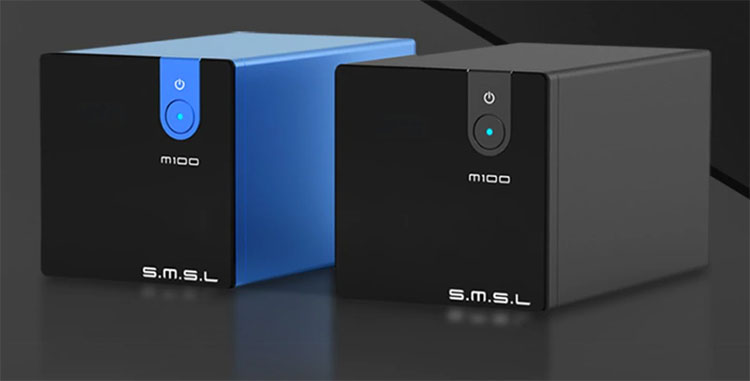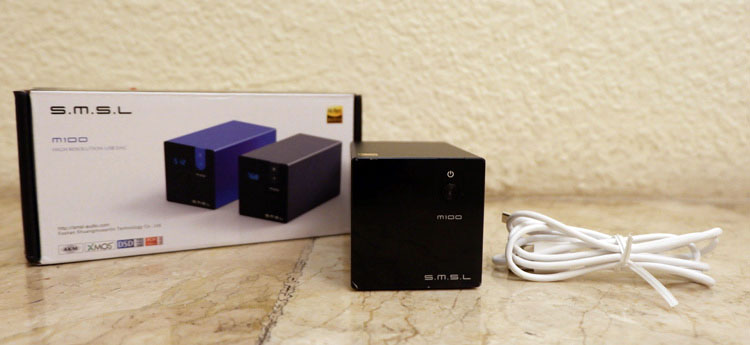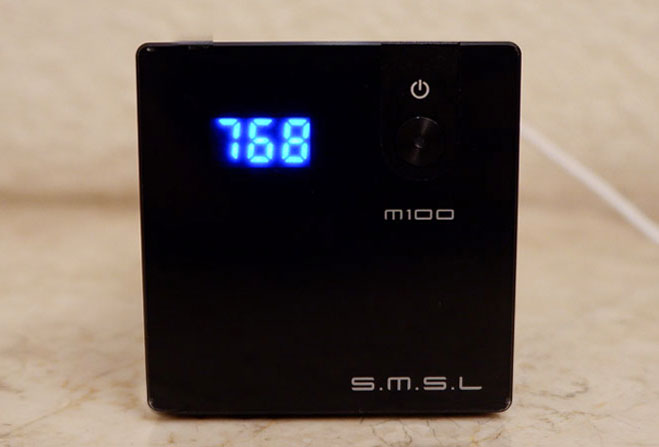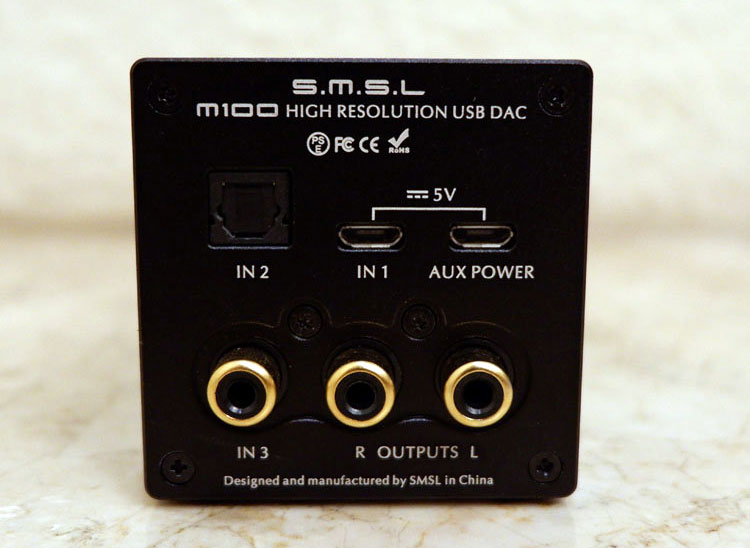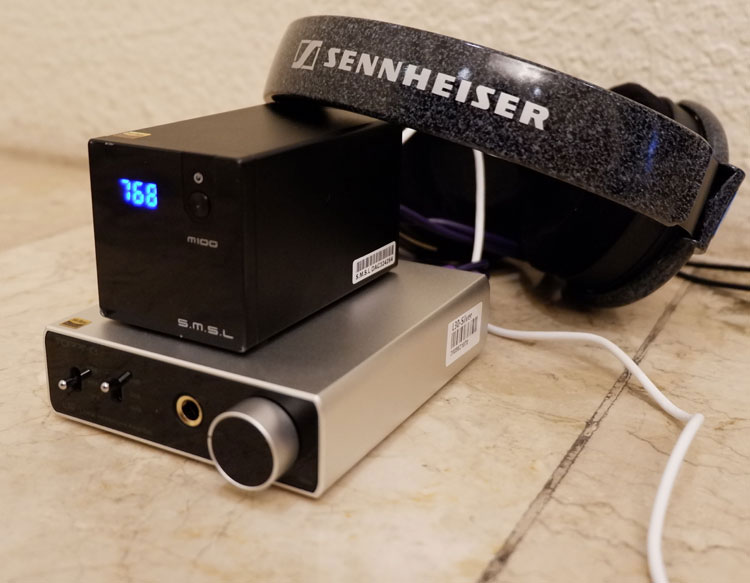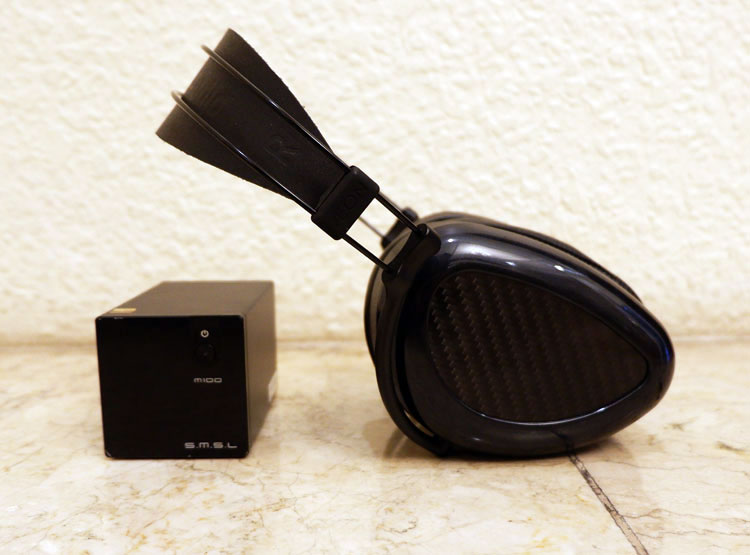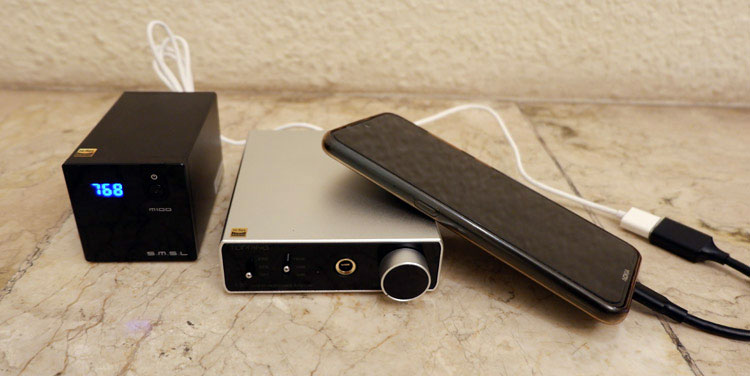The SMSL M100 MKII is a second-generation entry-level desktop DAC with an ES9018Q2C chipset supporting up to PCM768k/DSD512. It is priced at $93.99
Disclaimer: The SMSL M100 MKII sent to us for this review is a sample in exchange for our honest opinion. We thank Aoshida for giving us this opportunity.
To read more about SMSL reviews on Headfonics click here.
Note, this review follows our new scoring guidelines for 2020 which you can read up on here.
Background
SMSL has been producing DACs and amps from their headquarters in Shenzhen, China since 2009, and they have produced some segment-defining gear through the years. Their name SMSL comes from the first letters of the Chinese characters 双木三林, which roughly means two trees, three woods, (cryptic!).
SMSL has been doing quite a few things in the headphone industry recently, releasing its flagship DAC the V1, their THX-certified headphone amplifier, the SP200, and releasing their more affordable line of M series DAC’s. We have a few more SMSL reviews coming out also in the coming weeks.
They have just released an improved version of their entry-level M100 DAC, the M100 MKII, which has practically the same looks as the original but has a new DAC chip, and internal circuitry, and a PSE certification for the Japanese market.
Technology inside
DAC
Aesthetically, the M100 MKII looks the same at the original M100, the only physical difference is that the MKII version has a PSE mark. Although they are physically almost identical, the Mk2 version has changed the DAC chipset to the ESS Sabre 9018Q2C, from the original M100’s AKM 4452.
Notably, the DAC chip that SMSL chose is in the 9018 series, instead of the top of the line 9038 series that can be found in competing products. However, the DAC chip is not what makes or breaks a product, how things are implemented around the DAC chip will also make a big difference.
Another thing that SMSL was able to improve upon is a lower THD number than the original M100. The THD numbers are now 0.0003% instead of 0.0008% in the original version. This would ensure that we get a cleaner signal from the source.
Clock
Aside from the DAC chip inside, the other important components inside any DAC is the clock, and SMSL has invested in the M100 MKII by putting in 2 ultra-low phase noise clocks. Together with high-quality components such as MELF resistors, NP0 capacitors, and gold plated terminals, the M100 MKII looks like it will be able to produce a very linear output signal.
Topology
The M100 MKII also features an interesting shape, while most DAC’s are rectangular, this has a square form factor, which makes it have a smaller footprint on the table.
The shape that the M100 MKII took is not by accident though, as this shape allows the M100 to have a physically separate board for the digital section, and a separate board for the analog section. Which would allow for better noise isolation between the 2 sections, a perfect example of how the form would follow function.
On paper, the M100 MKII has modest specs, especially compared to the competition. But we’re not buying specs when we listen to a DAC, we are buying a listening experience.
This listening experience is changed by how the DAC is implemented, and I’m interested in how SMSL spent a bit more of their budget on high-quality components on the M100’s output stage, instead of a DAC chip with a higher model number.
Packaging & Accessories
The box that the M100 MKII came in gives away the shape of the box since the box is also a square prism. Inside are foam inserts, the manual, and a micro USB cable.
Nothing much comes with the M100 MKII in the box, and I’m glad that SMSL didn’t blow their budget on some unnecessary bells and whistles. They spent their tight budget on making sure that the M100 MKII can be the best product that it can be.
Design
It can be said that the M100 MKII was not updated since the original. There’s a single button in front that is used to select the inputs, the filters, and to toggle on/off. I would have wanted another button to make menu navigation a bit easier, but most DAC’s at this price point don’t even have a button or menu options, so I can’t complain that much.
On the left side of the power button is a blue 3 character 7-segment display. This displays the sampling rate that the DAC is currently running, and the other menu options once the menu options are triggered. Although I listen to a well-lit room, I was hoping that SMSL would have considered those who might be distracted with such a bright blue display with no way of dimming it.
At the back of the M100 MKII, we can find a pair of micro USB ports, 1 for the data/power input, and the other one for just powering the M100 through a 5V USB charger, where the manual kindly reminds us not to use quick charge adaptors that may damage the M100 due to overvoltage. Also available as inputs are optical, and coaxial digital.
Input selection on the M100 MKII is quite versatile as the USB ports can be driven off of a laptop as well as a cellphone through an OTG cable. However, I wish that the USB ports were upgraded to type C to get with the modern times, but I guess they continued to use the external parts of the original M100 on the MKII.
The only output is a pair of RCA jacks at the back, running 2V line output. There’s no pre-amp functionality on the M100 MKII, so it’s just a pure DAC giving a full line-level output.
Although not much has changed in the aesthetics of the DAC, I’m impressed by how small the footprint of this device is. I think SMSL did a great job the first time with the original M100, that they just used the same chassis in the MKII.
Features
Although practically physically identical to the original M100, a lot has changed in the under the hood. With the MKII version, there are digital filters! I wasn’t expecting that, since I barely expected a decent DAC at $94, let alone one that has digital filters.
Menu navigation might be a bit fidgety though. Pressing once would cycle through the inputs, holding the button would put the unit on standby mode.
Double-clicking would then show the digital filter(df) mode, where I can cycle through 3 DSD filters. Double-clicking again would show the jitter rejection mode(dp), with the higher numbers making the DAC more resistant to source jitter.
Digital filters (DSD)
In the manual, there was no explanation regarding the use of digital filters, it just says that there are 3 digital filters to choose from when the DAC is being used in DSD mode.
DSD filters are just low pass filters that would have a cut off frequency at some high frequency beyond the limits of human hearing.
However, higher filters will allow better presentation of transient response, at the expense of letting a bit more noise through as well. I left the M100 MKII on the dF1 setting because this was the one with the least amount of noise for me.
Sound Impressions
Bass
The bass on the M100 MKII is flat like the rest of the frequency response of this DAC, which is a good thing, as it isn’t supposed to change the frequency response too much.
What I liked about the bass on the M100 MKII is the way that the bass is present, but remains tight and controlled. When there is a drum beat, it feels like a distinct drum beat, and not at all scattered around other frequencies.
I especially liked how the M100 MKII was able to present the bassline of Chunky by Bruno Mars. It has presence and this tight rounded full-bodied quality that some lesser DACs end up messing up a bit.
The M100 MKII doesn’t increase the bass in any way, but it makes it much more enjoyable by making it tight and defined.
Midrange
The vocal range on the M100 MKII is generally flat but doesn’t end up becoming sterile. Look for the Good by Jason Mraz as a nice example.
Playing through the M100 MKII made Jason Mraz’s vocals shine through. The nuances and timbre of the voice on male vocal especially is well defined when being played through the M100, something that I don’t quite hear on some even more expensive DACs.
Treble
I always see myself as someone who is a bit treble sensitive, but my time as an audiophile has taught me to appreciate a good treble section when I hear it. With the M100, treble is well presented and easy to find. However, I would have wanted the treble to be a bit more nuanced, as the M100 MKII makes the treble sound a bit glossed over sometimes.
Treble on the M100 MKII is never peaky or scattered, but I would have wanted to be presented with a bit more detail in the treble section though.
Staging
The soundstage on the M100 MKII is about what I expected for a DAC at this price point, but I appreciate the amount of depth that the M100 can present. With the M100, I can almost hear the size of the room for recordings of live sessions like the one done by Echosmith for Bright. Hearing the way the singer’s voice bounces off the walls is not that hard with the M100 MKII in my chain.
Imaging is precise enough given that the M100 MKII is connected to resolving headphones. I found that the M100 MKII was pinpoint accurate with both my Sennheiser HD600, as well as my Dan Clark Audio Aeon Flow Closed RT.
Synergy
The M100 MKII is a DAC that has good linearity and resolution, with a bit of warmth and punchiness, so using a relatively flat amplifier is the logical pairing for the M100.
The first amplifier that I connected to the M100 MKII is the Schiit Magnius, which I found to have a flat frequency response, and it made good synergy with the SMSL M100 MKII. The pairing created a punchy sound, with some soundstage depth through my AEON Closed.
With the Magnius currently selling for $199, it might not be the most common pairing with the M100, so I connected the M100 MKII to the Topping L30, a $139 single-ended amplifier. This pairing might make more sense in terms of the price, and I can say that it also makes sense sonically. I found the L30 to be linear but tends to play catch up in faster passages.
The pairing with the M100 MKII is just right, as the M100 MKII’s tighter bass makes the L30 more defined and a little bit more capable of catching up to faster successive drum beats, and cymbal hits.
I would have wanted a bit more soundstage depth with this pairing though, and the pairing made my Hifiman Anandas sound relatively closed in comparison to running it off the Magnius connected to the M100.
Select Comparisons
Topping D10s
The Topping D10s and the SMSL M100 MKII are both priced below $100, which means they will be compared head to head most of the time. The form factor on the 2 devices are quite different, whereas the D10s is rectangular, the M100 MKII is a square prism.
This gives the M100 MKII a smaller footprint compared to the D10s. With the smaller form factor, the M100 has a much smaller display compared to the one on the D10s. Also, the one on the D10s is less distracting as it has a more subtle orange backlight that dims after a few minutes of use.
Although it seems that the number of connections at the back of both units is similar, the optical and SPDIF on the D10s are both outputs. The D10s only has 1 input which is a USB type B. The M100 MKII on the other hand, has 3 inputs, micro USB, coaxial and optical, no digital outputs, and a pair of RCA jacks for analog output.
Something to note on the M100 MKII as well is the presence of that single button mounted on the front. This gives the M100 MKII a bit more functionality, as it enables input selection and DSD filter selection.
Performance
SMSL made an interesting choice of DAC chip with the M100, where they used an ESS9018Q2C compared to the ESS9038Q2M found on the Topping D10s. The comparison between the 2 DACs has given me audible proof that the DAC chip should not be the sole consideration when choosing a DAC.
Instinctively, I initially thought that the D10s should be the clear winner between the 2, as it has a more “high-end” DAC chip, but it is not that simple.
Sonically, the 2 DACs are very similar in presentation. I found that the M100 MKII has a more rounded bass quality with a bit more depth in each drum beat. The piano timbre also feels slightly more natural and striking.
The D10s on the other hand has a slightly more forward and intimate presentation. The soundstage on both DACs is about the same width, but layering and instrument separation are more nuanced on the M100 MKII.
Topping E30
While the form factor of the Topping E30 is similar to the D10s, the available inputs and outputs on both the M100 MKII and the E30 are the same. At $40 more, we can expect some added functionalities on the E30, namely a remote control, PCM filters, and an option to use it as a preamp.
Of course, for the entirety of the review, I will be putting the E30 in at line output, to keep the comparisons equal.
The E30 comes with an AKM 4493 DAC chip, which comes from AK’s velvet sound line, which is supposed to give the DAC a low level of distortion, and high dynamic range. While the M100 MKII utilizes the ESS9018Q2C, which is believed to have a different house sound from DACs with the AKM chipset.
Performance
Despite the different chipsets being used on the 2 DACs, I hear quite a few similarities between the 2 DACs. They both have a dynamic character and quite a bit of some soundstage depth. While the E30 has a bit more width which gives the E30 a bit of an edge when it comes to layering.
The Bass impact is a bit more natural on the M100 MKII. The E30 on the other hand can present the nuances of treble a bit more clearly, the airiness of trumpets playing becomes more textured and present, and cymbal hits become slightly more distinct and impactful.
Both DACs sound very similar, the E30 tends to sound just a bit wider and airier when being compared to the M100 MKII’s slightly more impactful presentation.
Audioquest Dragonfly Red
It seems peculiar that I would compare a $199 dongle DAC to the SMSL M100 MKII, but I think it makes a bit of sense since the Dragonfly Red is one of the most well known DACs to feature an ESS DAC inside. It is a well-respected product when it launched, and it still is being used as a benchmark in the audiophile world today.
Although the Dragonfly Red can be used as a headphone amplifier on its own, I used it purely as a DAC for comparison purposes with the M100 MKII.
Due to the much smaller form factor, the Dragonfly Red only has a USB input and an analog output through a 3.5mm jack. While the M100 MKII ends up being the more versatile unit between the 2, with 3 inputs to choose from.
Performance
The 2 DACs both utilize ESS Sabre DACs, but I can hear that they are not sonically identical. With the Dragonfly Red being slightly more sparkly, which gives it a better sense of airiness as well. The Dragonfly Red also has a smoothed out upper mid-range where piano keys tend to sound flowier.
The M100 MKII tends to emphasize punch a bit more, where the mid-bass sounds very full and the midrange ends up being more textured comparatively. With the fuller midrange and punchier bass region though, the M100 MKII tends to sound slightly more closed in comparatively, but I believe it’s a byproduct of the M100’s tuning.
Detail retrieval on both DACs is about the same, as nuances and subtle cymbal hits are presented clearly on both devices.
The applications for each of the 2 DACs will be quite different, but sonically, I can hear that the M100 MKII can compete with such a widely respected DAC that’s still selling for around double the price of the M100 MKII today.
Our Verdict
Although DAC chips are an important consideration when choosing a DAC, it is not the sole predictor of what the DAC will sound like. Most manufacturers will play the numbers game by slapping on the highest model numbered DAC chip they can find to lure customers in.
SMSL designed the M100 MKII with a different approach. They went for the chip with a slightly lower model number, which I presume would preserve some of their budget allowing them to invest a bit more in the parts surrounding the chip.
With the M100’s physical isolation of the digital circuit from the analog circuit, to the higher grade components that make up the output stage of the DAC itself. This resulted in the M100 MKII being able to present a punchy but controlled bass region, and a defined and textured midrange.
I believe that the trade-off on the DAC chip is worth it, as SMSL was able to create a DAC that sounds more refined than what its price would suggest.
SMSL M100 MKII Specifications
- XMOS 2nd generation USB Audio solution.
- Supports PCM signal up to 32bit/768kHz and native DSD up to DSD512
- Two ultra-low phase noise crystal for 44.1/48kHz multiple frequencies
- High-performance 32bit/768kHz DAC (SABRE9018Q2C) for high dynamic range and more detail
- 121dB dynamic range (DNR)
- -115dB THD+N
- Built-in high-efficiency power module and lots of low-noise LDOs provide pure power for analog circuit
- Aux power supply for phones connection
- Lots of audio grade components include MELF resistors, NP0 capacitor, Gold-plated jacks

